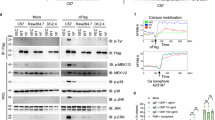Abstract
Activating (PIR-A) and inhibitory (PIR-B) isoforms of the paired immunoglobulin (Ig)-like receptor family have been evaluated for their modulating potential in mast cell responses to IgE antibody and mast/stem cell growth factor (SCF). Mast cells produce PIR-A and PIR-B, but PIR-B was found to be predominantly expressed on the cell surface, where it wasconstitutively tyrosine phosphorylated and associated with SHP-1 tyrosine phosphatase. Efficient coligation of PIR-B with FceRI inhibited IgE-induced mast cell activation and seroton in release. PIR-B and c-kit (or mast/SCF receptor) coligation also inhibited SCF-induced mast cell responses. The PIR-B inhibitory activity was unimpaired in SHP-1-deficient mast cells, perhaps because of non-SHP-1-binding tyrosine-based inhibitory motif in the cytoplasmic tail of PIR-B. This analysis suggests that PIR-B may serve to control mast cell activity.
Similar content being viewed by others
References
Kubagawa H, Burrows PD, Cooper MD; A novel pair of immunoglobulin-like receptors expressed by B cells and myeloid cells. Proc Natl. Acad Sci USA 1997:94: 5261–5266
Hayami KD, Fukuta, Y., Nishikawa, Y. et al. Molecular cloning of a novel murine cell-surface glycoprotein homologous to killer cell inhibitory receptors. J Biol. Chem 1997;272:7320–7327.
Reth M: Antigen receptor tailclue. Nature 1989:338:383–384.
Weiss A, Littman DR: Signal transduction by lymphocyte antigen receptors. Cell 1994;76:263–274.
Cambier JC: Antigenand Fc receptorsignaling: the awesome power of the immunore ceptor tyrosinebased activation motif (ITAM). J Immunol 1995;155:3281–3285.
Thomas ML. Of ITAMs and ITIMs: turningon and off the B cell antigen receptor. J Exp Med 1995; 181:1953–1956.
Scharenberg AM, Kinet JP: The emergingfieldofreceptor-mediated inhibitory signaling: SHP or SHIP? Cell 1996; 87:961–964.
Vivier E, Daëron M: Immunoreceptor tyrosine-based inhibition motifs. Immunol Today 1997;18: 286–291.
Vély F, Vivier E: Conservation of structural features reveals the existence of a large family of inhibitory cell surface receptorsand noninhibitory/activatory counterparts. J Immunol 1997;159: 2075–2077.
Ravetch JV, Lanier LL: Immune inhibitory receptors. Science 2000; 290:84–89.
Uehara T, Bléry M, Kang DW, et al.: Inhibition of IgE-mediatedmast cellactivation by the paired Ig-like receptor PIR-B. J Clin Invest 2001; 108:1041–1050.
Lobell RB, Ann JP, Raizman MB, et al.: Intracellular degradation of FcγRIII in mouse bone marrow culture-derived progenitor mast cells prevents its surface expression and associated function. J Biol Chem 1993;268:1207–1212.
Dombrowicz D, Flamand V, Miyajima I, et al: Absence of FcεR1 α chain results in upregulation of FcγRIII-dependent mast cell degranulation and anaphylaxis: evidence of competition between FcεR1 and FcγRIII for limiting amounts of FcR β and γ chains. J Clin Invest 1997;99:915–925.
Ho LH, Uehara T, Chen CC, et al: Constitutive tyrosine phosphorylation of the inhibitory paired 1g-like receptor PIR-B. Proc. Natl Acad Sci USA 1999;96: 15,086–15,090.
Kubagawa H, Chen CC, Ho LH, et al: Biochemical nature and cellular distribution of paired immunoglobulin-like receptors, PIR-A and PIR-B. J Exp Med 1999;189:309–317.
Bléry M, Kubagawa H, Chen CC, et al. The paired Ig-like receptor PIR-B is an inhibitory receptor that recruits the protein-tyrosine phosphatase SHP-1. Proc Natl Acad Sci USA 1998;95:2446–2451
Dubreuil P, Rottapel RR, Reith AD, et al.: The mouse W/c-kit locus: a mammalian gene that controls the development of three distinct cell lineages. Ann NY Acad Sci 1990; 599:58–65.
Malbec O, Fridman WH, Daîron M: Negative regulation of c-kit-mediated cell proliferation by FcγRIIB. J Immunol 1999;162: 4424–4429.
Yamashita Y, Ono M, Takai T: Inhibitory and stimulatory functions of paired 1g-like receptor (PIR) family in RBL-2H3 cells. J Immunol 1998;161:4042–4047.
Maeda A, Kurosaki M, Ono M, et al.: Requirement of SH2-containing protein tyrosine phosphatases SHP-1 and SHP-2 for paired immunoglobulin-like receptor B (PIR-B)-mediated inhibitory signal. J Exp Med 1998;187:1355–1360.
Maeda A, Scharenberg AM, Tsukada S, et al: Paired immunoglobulin-like receptor B (PIR-B) inhibits BCR-inducedactivationof Syk and B tk by SHP-1. Oncogene 1999;18:2291–2297.
Bruhns P, Marchetti P, Fridman WH, et al.: Differential roles of N-and C-terminal immunoreceptor tyrosine-based inhibition motifs during inhibition of cell activation by killer cell inhibitory receptors. J Immunol 1999;162:3168–3175.
Daëron M, Malbec O, Latour S, et al: Regulation of high-affinity IgE receptor-mediated mast cell activation by murine low-affinity IgG receptors. J Clin Invest 1995;95: 577–585.
Katz HR, Vivier E, Castells MC, et al: Mouse mastcellgp49B 1 contains two immunoreceptor tyrosine-based inhibitory motifs and suppresses mast cell activation when coligated with the highaffinity Fc receptor for IgE. Proc Natl Acad Sci USA 1996;93: 10,809–10,814.
Daëron M, Sylvain L, Malbec O, et al.: The same tyrosine-based inhibition motif, in the intracytoplasmic domain of FcγRIIB, regulates negatively BCR-, TCR-, and FcR-dependent cell activation. Immunity 1995;3:635–646.
Xu R, Pecht I: The mast cell function-associated antigen, a new member of the ITIM family. Curr TopMicrobiol Immunol 1999;244: 159–168.
Liénard H, Bruhrs P, Malbec O, et al. Signal regulatory proteins negatively regulate immunoreceptor-dependent cell activation. J Biol Chem 1999;274:32,493–32,499.
Samaridis J, Colonna M: Cloning of novel immunoglobulin superfamily receptors expressed on human myeloid and lymphoid cells: structural evidence for new stimulatory and inhibitory pathways. Eur J Immunol 1997;27: 660–665.
Cosman D, Fanger N, Borges L, et al. A novel immunoglobulin superfamily receptor for cellular and viral MHC class I molecules. Immunity 1997;7:273–282.
Wagtmann N, Rojo S, Eichler E, et al. A new human gene complex encoding the killer cells inhibitory receptors and related monocyte/macrophage receptors Curr Biol 1997;7:615–618.
Arm JP, Nwankwo C, Austen KF: Molecularide nitificationofa novel family of human Ig superfamily members that prossess immunoreceptor tyrosine-based inhibition motifsand, homology to the mouse gp49B1 inhibitory receptor. J Immunol 1997;159:2342–2349.
Ott VL, Cambier JC. Activating and inhibitory signaling in mast cells: new opportunities for therapeutic intervention. J Allergy Clin Immunol 2000;106:429–440.
Author information
Authors and Affiliations
Corresponding author
Rights and permissions
About this article
Cite this article
Chen, CC., Kang, DW., Cooper, M.D. et al. Mast cell regulation via paired immunoglobulin-like receptor PIR-B. Immunol Res 26, 191–197 (2002). https://doi.org/10.1385/IR:26:1-3:191
Issue Date:
DOI: https://doi.org/10.1385/IR:26:1-3:191




